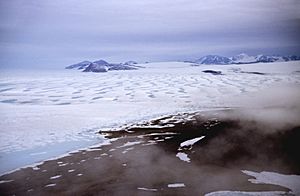Ward Hunt Ice Shelf facts for kids

The Ward Hunt Ice Shelf is the largest ice shelf in the Arctic. It is found on the northern coast of Ellesmere Island in Nunavut, Canada. For about 4,000 years, this ice shelf was part of a much larger ice sheet that covered the whole northern coast of Ellesmere Island.
During the 1900s, the big Ellesmere Ice Shelf broke into six smaller shelves. The Ward Hunt Ice Shelf is the biggest of these pieces. Today, it is about 400 square kilometers (155 square miles) in size. In 2005, another part of the Ellesmere Ice Shelf, called the Ayles Ice Shelf, completely broke off. It was about 65 square kilometers (25 square miles) in size.
Contents
Discovering the Ice Shelf
Explorers have known about the Ellesmere Ice Shelf for a long time. The British Arctic Expedition of 1875-76 explored this area. Lieutenant Pelham Aldrich and his team traveled along the coast, including the Ward Hunt Ice Shelf.
Later, in 1906, explorer Robert Peary described a "broad glacial fringe" along much of the coast of northwestern Ellesmere Island. This shows that the ice shelf was very large back then.
How the Ice Shelf is Changing
The Ward Hunt Ice Shelf started to break apart about 100 years ago. People thought it had stopped breaking up by the early 1980s. However, this changed in the 2000s.
Cracks and Splits
In April 2000, satellite pictures showed a large crack forming in the ice. By 2002, the ice shelf had completely split into two pieces. When it split, a huge amount of fresh water was released from a special lake called an epishelf lake. This lake was in Disraeli Fjord and was the biggest of its kind in the Northern Hemisphere.
In April 2008, scientists found that the ice shelf had many new, deep cracks. In late July 2008, nearly 20 square kilometers (8 square miles) of ice broke away from the shelf. Then, in August 2010, another 50 square kilometers (19 square miles) broke off from the northeast part of the ice shelf.
Why the Ice is Breaking
The breaking up of the Ward Hunt Ice Shelf is linked to warmer temperatures in the Arctic. The average temperature in this region has been going up a lot over the past few decades. Scientists connect these changes to global warming.
What Happens Next
When large pieces of ice break off, they become icebergs. These icebergs can be dangerous for ships and for any oil or gas work happening in the ocean nearby.
The release of fresh water from the epishelf lake also affects the environment. It can harm the tiny living things (microbes) that live in these unique ecosystems. This could have big impacts on the plants and animals that depend on them.


